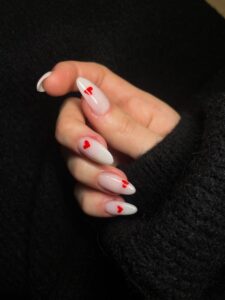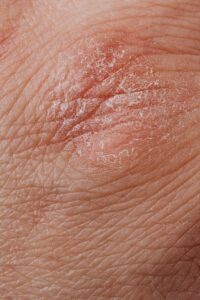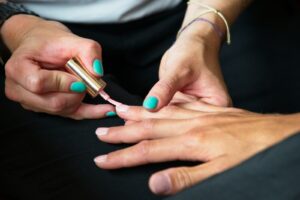Understanding Health Risks: Allergic Reactions to Gel and Acrylic Nails in Salons
In the quest for beautiful nails, many individuals turn to acrylic and gel nails, often applied in salons by skilled nail technicians. While these nail treatments can enhance the appearance of natural nails, they also pose potential health risks, particularly allergic reactions. Understanding the differences between these two popular nail products and their associated risks is essential for maintaining nail health and ensuring a safe manicure experience.
The Basics of Acrylic and Gel Nails

Photo by Linda Markaj on Pexels
Acrylic and gel nails are popular choices for those seeking long-lasting and visually appealing manicures. Acrylic nails are typically created using a combination of a liquid monomer and a powdered polymer, forming a durable layer over the natural nail. This process involves shaping the acrylic over the nail plate, often using nail glue to secure it in place. In contrast, gel nails are made from a gel-like substance that requires a UV lamp to cure, resulting in a glossy finish that many people find attractive. Both types of nails can enhance the look of natural nails, but they also have different implications for nail health.
What are Acrylic Nails?
Acrylic nails are a popular choice among nail professionals due to their strength and versatility. Made from a mixture of liquid monomer and powdered polymer, these fake nails are applied over the natural nail or nail bed, creating an artificial enhancement. Acrylic nails can be shaped and polished to the desired style, allowing for creativity in nail art. However, the chemicals in acrylic nail products, particularly acrylates, may cause allergic reactions in some individuals, resulting in conditions like allergic contact dermatitis. Regular maintenance and proper nail care are vital to prevent nail damage and ensure healthy nail growth.
Understanding Gel Nails
Gel nails offer an alternative to acrylics, utilizing a gel formula that is cured under a UV lamp, which hardens the polish and creates a durable finish. Gel polish manicures are often favored for their natural appearance and long-lasting wear, as they do not require the filing of the natural nail to the same extent as acrylics. However, gel products also contain chemicals that can lead to allergic reactions in sensitive individuals. The skin around the nail may become irritated, and it is crucial for clients in nail salons to communicate with their nail techs about potential allergies to avoid adverse effects.
Comparison of Acrylic and Gel Nail Products
When comparing acrylic and gel nails, several factors come into play, including durability, appearance, and potential health risks. Acrylic nails tend to be more robust and can withstand more wear and tear, making them ideal for clients seeking longevity. Conversely, gel nails offer a more natural look and feel, often appealing to those prioritizing aesthetics. However, both options contain allergens that may cause allergic reactions, necessitating patch tests before application. Proper ventilation in nail salons and the use of hypoallergenic products, such as hema-free gel polish, can help mitigate these health risks while still providing beautiful nails.
Health Risks Associated with Nail Products
As the popularity of gel and acrylic nails continues to rise in salons, it is essential to understand the health risks associated with these nail products. While many people enjoy the aesthetic appeal of manicures using gel and acrylic, the potential for allergic reactions and skin irritation cannot be overlooked. Nail technicians must be aware of the ingredients in the products they use, such as methacrylates, which are common allergens found in acrylic nail products. Furthermore, ensuring proper ventilation in nail salons is crucial to minimize exposure to harmful fumes that can exacerbate health risks for both clients and nail professionals.
Common Allergic Reactions to Nail Products
Allergic reactions to nail products can manifest in various ways, with symptoms ranging from mild irritation to severe dermatitis. Many individuals may experience contact dermatitis, which is characterized by redness, itching, and swelling around the nail and skin areas. Certain chemicals, especially those found in gel polish and acrylic nail formulations, can trigger these allergic reactions. For instance, acrylates are known allergens that can cause discomfort and may lead to chronic skin conditions if left untreated. Clients should always communicate their history of nail product allergies to their nail tech to ensure a safe manicure experience.
Contact Dermatitis and Its Symptoms
Contact dermatitis is a common condition that can arise from exposure to allergens in nail products. Symptoms include redness, itching, and blistering of the skin around the nail area. In some cases, this condition can become chronic, leading to ongoing irritation and discomfort. Those who frequently use acrylic or gel nails may find that repeated exposure increases their sensitivity, making them more susceptible to allergic reactions. It is advisable for individuals experiencing symptoms to consult a dermatologist for appropriate treatment and to consider alternatives to traditional nail products that may be less irritating to their skin.
Long-term Effects on Nail Health
Long-term use of acrylic and gel nails can have detrimental effects on nail health. The application process often involves the use of strong adhesives and acetone, which can weaken the natural nail over time. Additionally, frequent manicures may hinder the growth and regeneration of the natural nail plate, leading to brittleness and increased susceptibility to fungal infections. Clients should prioritize nail care between treatments and consider taking breaks from acrylic or gel applications to allow their nails to recover. By being mindful of the health risks associated with nail products, individuals can maintain healthy nails while enjoying beautiful manicures.
Identifying Allergic Reactions
Signs of Allergic Reactions to Acrylic Nails
Recognizing the signs of allergic reactions to acrylic nails is crucial for maintaining nail health and comfort. Symptoms often manifest shortly after application, with

Photo by Karolina Kaboompics on Pexels
being a common response. Individuals may experience redness, swelling, and itching in the skin around the nail and nail bed, which can escalate to blistering in severe cases. Additionally, some may notice a burning sensation or increased sensitivity in the area. It is essential for clients to communicate these symptoms to their nail technician immediately, as this can help prevent further irritation and guide the choice of alternative nail products that are less likely to cause allergic reactions.
How to Differentiate Between Allergies and Other Conditions
Differentiating between allergic reactions and other nail-related conditions can be challenging for both clients and nail professionals. Allergic reactions typically present with specific symptoms such as intense itching and localized redness, while other conditions, like fungal infections, may cause discoloration, nail separation, or unusual growth patterns. Consulting with a dermatologist can provide clarity, as they can conduct patch tests to identify specific allergens. Understanding the differences can help clients make informed decisions about nail treatments and avoid products that could exacerbate pre-existing conditions, ultimately leading to healthier nails and a more enjoyable manicure experience.
When to Seek Medical Attention
It is vital to know when to seek medical attention regarding allergic reactions to nail products. If symptoms persist or worsen despite removing the acrylic or gel nails, individuals should consult a healthcare professional. Signs that warrant immediate medical attention include severe swelling, difficulty breathing, or the development of hives, as these could indicate a more serious allergic reaction. Additionally, if contact dermatitis results in open sores or signs of infection, such as pus or fever, timely intervention is critical. By being proactive about nail health and recognizing the need for medical evaluation, individuals can effectively manage their reactions and maintain their overall well-being.
Alternatives to Acrylic and Gel Nails

Photo by Stefan Lehner on Unsplash
Natural Nail Care Practices
For those seeking alternatives to acrylic and gel nails, embracing natural nail care practices can be highly beneficial. Focusing on the health of the natural nail involves using nourishing oils and creams to maintain moisture, which can prevent brittleness and breakage. Regular trimming, filing, and gentle buffing can enhance the appearance of the nails without the need for artificial enhancements. Additionally, ensuring a balanced diet rich in vitamins and minerals promotes nail growth and strength. By prioritizing natural nail care, individuals can enjoy beautiful, healthy nails without the risks posed by nail products like acrylic and gel.
Healthier Nail Product Options
Exploring healthier nail product options can help individuals maintain their nail aesthetics while minimizing health risks. Products that are free from harmful chemicals, such as formaldehyde, toluene, and dibutyl phthalate, are ideal for those concerned about allergic reactions. Hema-free gel polish is an excellent alternative as it reduces the likelihood of irritation and allergic contact dermatitis. Additionally, opting for water-based nail polishes can also be a safer choice, as they are less likely to cause adverse skin reactions. By carefully selecting nail products, individuals can achieve beautiful manicures while prioritizing their nail health.
DIY Nail Treatments for Better Nail Health
DIY nail treatments offer a creative and cost-effective way to enhance nail health without resorting to acrylic or gel applications. Simple recipes using natural ingredients, such as olive oil, lemon juice, and vitamin E, can be used to nourish and strengthen the nails. Soaking the nails in warm olive oil not only hydrates the nail plate but also promotes blood circulation to the nail bed. Regular application of homemade scrubs can help remove dead skin and improve overall nail aesthetics. Embracing these DIY treatments can lead to healthier nails and reduce reliance on salon treatments.
Preventing Allergic Reactions in Salons

Photo by Delbeautybox on Pexels
Choosing the Right Nail Salon
Selecting the right nail salon is crucial for avoiding allergic reactions to nail products. A reputable salon should prioritize client safety by using high-quality, hypoallergenic products and ensuring proper ventilation to mitigate exposure to harmful fumes. Checking for cleanliness and the qualifications of nail technicians is equally important, as skilled professionals are more likely to understand the ingredients in their products and the potential for allergic reactions. Reading reviews and asking for recommendations can also guide individuals towards salons that prioritize both aesthetic and health considerations in their nail treatments.
Communicating Your Allergies to Nail Technicians
Effective communication with nail technicians is essential for preventing allergic reactions during nail treatments. Clients should openly discuss any known allergies or sensitivities related to nail products, particularly to acrylates and methacrylates commonly used in acrylic and gel nails. Nail technicians can then tailor their services to accommodate these allergies, potentially using alternative products or techniques. It is advisable for clients to inquire about the specific ingredients in the products being used, ensuring a safe and comfortable experience. By fostering clear communication, clients can enjoy their manicures without the fear of adverse reactions.
Understanding Ingredient Labels on Nail Products
Understanding ingredient labels on nail products is vital for those concerned about allergic reactions. Many nail products contain acrylates, which are known allergens that can trigger skin irritation and allergic contact dermatitis. Clients should familiarize themselves with common ingredients found in gel and acrylic products, such as acetone and methacrylates, to identify potential allergens. Additionally, seeking out brands that provide transparent ingredient lists can help consumers make informed choices. By carefully scrutinizing product labels, individuals can reduce the risk of allergic reactions and choose safer alternatives for their nail health.
What is the difference between gel and acrylic nails?
The primary difference between gel and acrylic nails lies in their composition and application process. Acrylic nails are created using a mixture of a liquid monomer and a powder polymer, which forms a hard protective layer over the natural nail. In contrast, gel nails are made from a gel-like substance that is cured under a UV light, resulting in a more flexible finish. Both options have their unique advantages, but it ultimately depends on your personal preference for durability and aesthetic appeal.
Are there any health risks associated with nail products?
While most nail products are safe when used correctly, there can be health risks if you’re not careful. Some individuals may experience an allergic reaction to ingredients found in nail polish or acrylic nail products, leading to symptoms like redness, irritation, or even contact dermatitis. It’s essential to perform a patch test before applying new products and to ensure proper ventilation in the salon during treatments.
What should I do if I experience an allergic reaction to nail products?
If you suspect that you’re experiencing an allergic reaction, it’s important to stop using the product immediately. Rinse the area with water and apply a soothing lotion if necessary. If the symptoms persist or worsen, consult a dermatologist for professional advice. They can help identify the specific allergen and recommend suitable alternatives that won’t compromise your nail health.
How can I ensure the health of my natural nails?
To maintain healthy nails, prioritize regular nail care routines. Keep your natural nails trimmed and shaped, and avoid using nail products that contain harsh chemicals. Moisturizing the skin around the nail and using a good nail treatment can also help in promoting nail growth. Moreover, consider incorporating nail polish with nourishing ingredients, such as vitamins and minerals, which can provide additional benefits while still allowing you to enjoy a polished look. Look for products that are labeled “5-free” or “10-free,” as these are formulated without many common harmful chemicals such as formaldehyde, toluene, and dibutyl phthalate.
In addition to using quality products, maintain a balanced diet rich in biotin, zinc, and protein, as these nutrients play a crucial role in nail health. Foods like eggs, nuts, leafy greens, and fish can contribute to stronger, healthier nails.
It’s also essential to protect your nails from excessive exposure to water and harsh cleaning agents. Wearing gloves while doing household chores can prevent nails from becoming brittle and breaking.
Lastly, be mindful of any habits that may harm your nails, such as biting or picking. If you notice any persistent issues like discoloration, pain, or unusual growth patterns, consult a dermatologist or a healthcare professional for further evaluation. With consistent care and attention, you can achieve beautiful and resilient nails.


